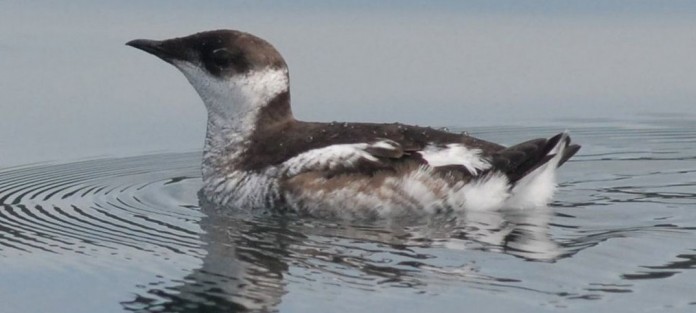
Social media has become an effective way for interest groups to reach new audiences. So I wasn’t surprised when a Facebook feed sent me to a YouTube video promoting conservation.
What did surprise me was that the message came from the National Park Service in rap form. The clever video shines a spotlight on the plight of the endangered marbled murrelet, a small seabird related to puffins that lives along the Pacific coast from northern California to Alaska.
Nesting season
During most of the year, it can be seen within three miles of shore, but in spring during the nesting season these small seabirds fly as far as 50 miles inland to nest near the tops of tall, ancient trees. Until 1974, no one knew where these birds nested. The first North American nest was discovered high on a moss-covered branch in old growth timber.
It’s safe to say ornithologists were surprised to find a seabird nesting high in old growth trees miles from shore. Most nests are found in similar locations, but some have been found on rocky, ocean-facing cliffs.
Conservationists
A typical nest tree is 200 to 300 feet tall and several hundred years old. This is just one reason conservationists strive to protect old growth forests. It’s difficult to study what goes on hundreds of feet above the ground, so clear cutting these forests is simply irresponsible. It’s hard to protect and manage a resource that cannot be seen.
Eggs
Eggs are usually laid directly on the thick bed of mosses that cover large horizontal limbs in the treetops. Murrelets do not actually build a nest. Ground nests are just scrapes in lichens, mosses, and other organic debris.
Murrelets take turns incubating a single egg in 24-hour shifts. The egg hatches in about 30 days. Hatched fully feathered in a thick yellow down, the chick is brooded by its parents for only a day or two.
Menu
While in the nest, the chick is fed up to eight times a day. The menu consists of small fish almost exclusively. The chick leaves the nest after 27 to 40 days. The flight from the nest to the ocean is a vulnerable time. The farther inland the nest is located, the greater the chance that the flight will fail. This is after all, the chick’s first flight.
Flying
If a chick is grounded, it is likely to die. Even adult murrelets cannot simply jump into the air and fly. They must launch from an elevated perch. So if a newly fledged bird can’t find a launching pad, it will die. The parents do not care for the chick after it leaves the nest. If it reaches the ocean, it finds its way to other recently fledged murrelets and they form social flocks.
Predators
Nest predation by ravens, crows, and jays is a major mortality factor. They eat both eggs and nestlings, and this is particularly devastating to birds that lay just one egg per year.
Historically, scattered and isolated nest locations made it difficult for predators to find nests, but today hikers and campers unknowingly wander the ground beneath nest trees. And where people go, garbage usually follows.
Feast
It turns out that crows, ravens, and jays learn to follow people to feast on the crumbs and scraps they leave behind. And after they reach a nesting area, it doesn’t take long for them to find nests. Exploring tree limbs hundreds of feet above the ground is no problem for hungry birds.
And that’s the point of the video. Hikers, campers, and other park visitors should pack their garbage out not only because it’s the right thing to do, but also because it improves the nesting success of marbled murrelets.
Video
Rather than put out a traditional press release that would be largely ignored, the National Park Service produced a short video, “Rangsta” Rap: Marbled Murrelet (written and directed by Ryan Spencer) to tell the bird’s story. What a great way to trigger young people’s interest in conservation.
To see the video, go to www.youtube.com and search for the video by name.












